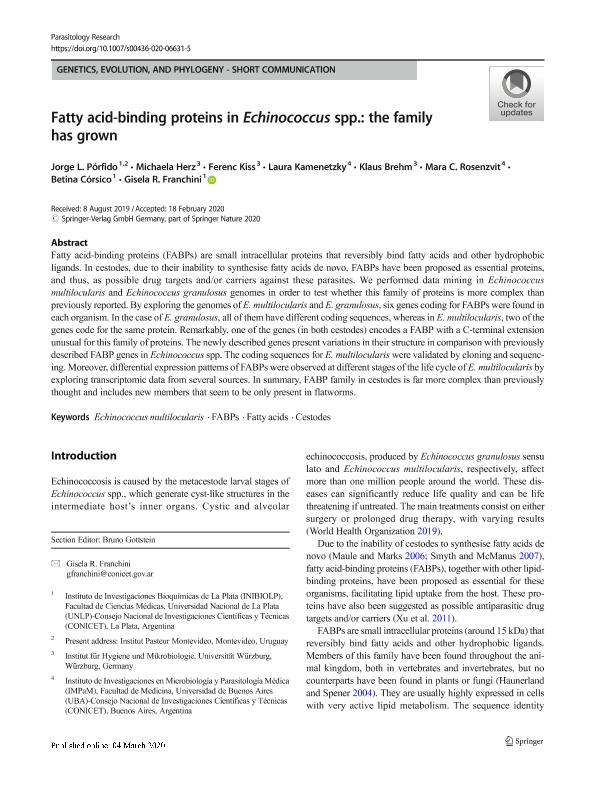Artículo
Fatty acid-binding proteins in Echinococcus spp.: the family has grown
Pórfido, Jorge Luis ; Herz, Michaela; Kiss, Ferenc; Kamenetzky, Laura
; Herz, Michaela; Kiss, Ferenc; Kamenetzky, Laura ; Brehm, Klaus; Rosenzvit, Mara Cecilia
; Brehm, Klaus; Rosenzvit, Mara Cecilia ; Córsico, Betina
; Córsico, Betina ; Franchini, Gisela Raquel
; Franchini, Gisela Raquel
 ; Herz, Michaela; Kiss, Ferenc; Kamenetzky, Laura
; Herz, Michaela; Kiss, Ferenc; Kamenetzky, Laura ; Brehm, Klaus; Rosenzvit, Mara Cecilia
; Brehm, Klaus; Rosenzvit, Mara Cecilia ; Córsico, Betina
; Córsico, Betina ; Franchini, Gisela Raquel
; Franchini, Gisela Raquel
Fecha de publicación:
03/2020
Editorial:
Springer
Revista:
Parasitology Research
ISSN:
0932-0113
Idioma:
Inglés
Tipo de recurso:
Artículo publicado
Clasificación temática:
Resumen
Fatty acid-binding proteins (FABPs) are small intracellular proteins that reversibly bind fatty acids and other hydrophobic ligands. In cestodes, due to their inability to synthesise fatty acids de novo, FABPs have been proposed as essential proteins, and thus, as possible drug targets and/or carriers against these parasites. We performed data mining in Echinococcus multilocularis and Echinococcus granulosus genomes in order to test whether this family of proteins is more complex than previously reported. By exploring the genomes of E. multilocularis and E. granulosus, six genes coding for FABPs were found in each organism. In the case of E. granulosus, all of them have different coding sequences, whereas in E. multilocularis, two of the genes code for the same protein. Remarkably, one of the genes (in both cestodes) encodes a FABP with a C-terminal extension unusual for this family of proteins. The newly described genes present variations in their structure in comparison with previously described FABP genes in Echinococcus spp. The coding sequences for E. multilocularis were validated by cloning and sequencing. Moreover, differential expression patterns of FABPs were observed at different stages of the life cycle of E. multilocularis by exploring transcriptomic data from several sources. In summary, FABP family in cestodes is far more complex than previously thought and includes new members that seem to be only present in flatworms.
Palabras clave:
CESTODES
,
ECHINOCOCCUS MULTILOCULARIS
,
FABPS
,
FATTY ACIDS
Archivos asociados
Licencia
Identificadores
Colecciones
Articulos(IMPAM)
Articulos de INSTITUTO DE INVESTIGACIONES EN MICROBIOLOGIA Y PARASITOLOGIA MEDICA
Articulos de INSTITUTO DE INVESTIGACIONES EN MICROBIOLOGIA Y PARASITOLOGIA MEDICA
Articulos(INIBIOLP)
Articulos de INST.DE INVEST.BIOQUIMICAS DE LA PLATA
Articulos de INST.DE INVEST.BIOQUIMICAS DE LA PLATA
Citación
Pórfido, Jorge Luis; Herz, Michaela; Kiss, Ferenc; Kamenetzky, Laura; Brehm, Klaus; et al.; Fatty acid-binding proteins in Echinococcus spp.: the family has grown; Springer; Parasitology Research; 119; 4; 3-2020; 1401-1408
Compartir
Altmétricas



